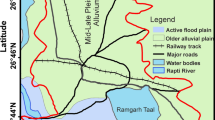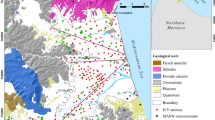Abstract
The town of Haenam in southwest Korea lies partially on reclaimed coastal land and experienced an unprecedented earthquake swarm during April and May 2020. Construction of a new town in the area means that there is demand to evaluate the seismic hazard caused by site-specific amplification of seismic ground motions by artificial unconsolidated cover. We used a microtremor horizontal-to-vertical spectral ratio (HVSR) method to identify resonance frequencies, image depths to bedrock, and assess seismic ground vulnerability across the epicentral area of the recent earthquake swarm. Microtremor measurements were taken at 144 sites across an 18.5 km × 12.5 km study area. The HVSR analysis shows resonance frequencies as low as 1.1 Hz. Using mean shear-wave velocities obtained by Multi-Channel Analyses of Surface Waves (MASW), we find that resonance frequencies correspond to depths to bedrock of between 3 m and 56 m. There are clear relationships between the distribution of resonance frequencies, depths to bedrock, surface geology, and areas of development in recent land reclamation projects. Higher resonance frequencies characterize areas of thin sedimentary cover or hard rock sites, while relatively low resonance frequencies characterize reclaimed land or greater depths to bedrock. We quantify the seismic hazard potential across the study area using the seismic vulnerability of ground index (Kg), and observe a clear association between zones of high Kg and areas of reclaimed land. This study demonstrates the value of the HVSR technique in characterizing the subsurface and assessing seismic vulnerability in areas of reclaimed land, where it can be used as a viable and low-cost alternative to large-scale active seismic refraction or MASW measurements. The results can also be used to inform and guide urban planning projects.
Similar content being viewed by others
References
Abd El-Aal, A.E.A.K., 2010, Modelling of seismic hazard at the northeastern part of greater Cairo metropolitan area, Egypt. Journal of Geophysics and Engineering, 7, 75–90.
Anderson, J.G., Bodin, P., Brune, J.N., Prince, J., Singh, S.K., Quaas, R., and Onate, M., 1986, Strong ground motion from the Michoacan, Mexico, Earthquake. Science, 233, 1043–1049. https://doi.org/10.1126/science.233.4768.1043
Assatourians, K. and Atkinson, G., 2010, Database of processed time series and response spectra data for Canada: an example application to study of 2005 MN 5.4 Rivier du Loup, Quebec, Earthquake. Seismological Research Letters, 81, 1013–1031.
Becken, M., Ritter, O., Bedrosian, P.A., and Weckmann, U., 2011, Correlation between deep fluids, tremor and creep along the central San Andreas fault. Nature, 480, 87–90.
Bottelin, P., Dufréchou, G., Seoane, L., Llubes, M., and Monod, B., 2019, Geophysical methods for mapping Quaternary sediment thickness: application to the Saint-Lary basin (French Pyrenees). Comptes Rendus Geoscience, 351, 407–419.
Chang, S.-J. and Baag, C.-E., 2007, Moho depth and crustal Vp/Vs variation in southern Korea from teleseismic receiver functions: implication for tectonic affinity between the Korean Peninsula and China. Bulletin of the Seismological Society of America, 97, 1621–1631.
Chatelain, J.-L., Guillier, B., Cara, F., Duval, A.-M., Atakan, K., Bard, P.-Y., and The WP02 SESAME team, 2008, Evaluation of the influence of experimental conditions on H/V results from ambient noise recordings. Bulletin of Earthquake Engineering, 6, 33–74.
Chough, S.K., Kwon, S.-T., Ree, J.-H., and Choi, D.K., 2000, Tectonic and sedimentary evolution of the Korean peninsula: a review and new view. Earth-Science Reviews, 52, 175–235.
Dahm, T., Hrubcová, P., Fischer, T., Horálek, J., Korn, M., Buske, S., and Wagner, D., 2013, Eger Rift ICDP: an observatory for study of nonvolcanic, mid-crustal earthquake swarms and accompanying phenomena. Scientific Drilling, 16, 93–99.
Geopsy Group, 2019, Geopsy Package Release 3.2.0. http://www.geopsy.org/download.php?platform=win64&release=3.2.0 [Accessed on 4 March 2019].
Google Earth, 2020, Images of Haenam, Korea, available on Google Earth between 1984 and 2020. http://www.google.com/earth/index.html [Accessed on 21 July 2020].
Han, J., Seo, W., Kim, H.-J., Kim, W.-Y., Won, D., Jeong, J.-I., and Kim, K.-H., 2020, Monitoring a short-lived earthquake swarm between April–May 2020 in Haeman, Korea, and its preliminary results. Geosciences Journal, 25. (in press)
Hardesty, K., Wolf, L.W., and Bodin, P., 2010, Noise to signal: a microtremor study at liquefaction sites in the New Madrid Seismic Zone. Geophysics, 75, B83–B90.
Hassani, B. and Atkinson, G.M., 2016, Applicability of the site fundamental frequency as a VS30 proxy for central and eastern North America. Bulletin of the Seismological Society of America, 106, 653–664.
Holzer, T.L., 1995, The Hanshin-Awaji (Kobe), Japan, Earthquake. GSA Today, 5, 154–167.
Holzer, T.L. and O’ Rourke, T.D., 1990, Effects of the Loma Prieta earthquake on the Marina District, San Francisco, California. Open File Report No. 90-253, U.S. Geological Survey, Menlo Park, 128 p.
Hong, J.K., Kim, K.Y., and Choi, D.-L., 1999, A high-resolution seismic survey on the abandoned tidal flat in Shihwa Lake. Journal of the Korean Geophysical Society, 2, 251–258.
Huang, H.-C. and Tseng, Y.-S., 2002, Characteristics of soil liquefaction using H/V of microtremors in Yuan-Lin area. Taiwan Terrestrial, Atmospheric and Oceanic Sciences, 13, 325–338.
Ibs-von Seht, M. and Wohlenberg, J., 1999, Microtremor measurements used to map thickness of soft sediments. Bulletin of the Seismological Society of America, 89, 250–259.
Ishihara, K. and Koga, Y., 1981, Case Studies of Liquefaction in the 1964 Niigata Earthquake. Soils and Foundations, 21, 35–52.
Jeollanamdo, 2020, SolaSeaDo, Jeollanamdo Enterprise Cities Office. http://solaseado.go.kr/ [Accessed on 18 July, 2020]
Jou, H.-T., Kim, H.-J., Lee, G.-H., Lee, S.-H., Jung, B.-H., Cho, H.-M., and Jang, N.-D., 2008, Seismic imaging of a tidal flat: a case study for the Mineopo area. Mulli-Tamsa, 11, 197–203.
Kang, S.Y., Kim, K.-H., Chiu, J.-M., and Liu, L., 2020, Microtremor HVSR analysis of heterogeneous shallow sedimentary structures at Pohang, South Korea. Journal of Geophysics and Engineering. https://doi.org/10.1093/jge/gxaa035
KIGAM, 2010, Geology map of Korea, Korea Institute of Geosciences and Mineral Resources, Daejeon.
KIGAM, 2020, Geological Map of Korea, https://mgeo.kigam.re.kr/ [Accessed on March 10 2020].
Konno, K. and Ohmachi, T., 1998, Ground-motion characteristics estimated from spectral ratio between horizontal and vertical components of ambient noise. Bulletin of the Seismological Society of America, 88, 228–241.
Kwon, J. and Kim, K.-H., 2019, Ambient noise of temporary seismic stations in Gyeongju, Korea. The 74th Annual Meeting of the Geological Society of Korea and 2019 Fall Joint Conference of the Geological Sciences, Jeju, Oct. 23–26, p. 243.
Kyung, J.-B., 2020, Historical earthquake swarm (1565–1566) in the Sangwon area, Korea. Geosciences Journal, 25. (in press)
Lachet, C. and Bard, P.-Y., 1994, Numerical and theoretical investigations on the possibilities and limitations of Nakamura’s Technique. Journal of Physics of the Earth, 42, 377–397.
Lee, H., Kim, R., and Kang, T.-S., 2017, Seismic response from microtremor of Chogye Basin, Korea. Geophysics and Geophysical Exploration, 20, 88–95.
Lee, K. and Yang, W.-S., 2006, Historical seismicity of Korea. Bulletin of the Seismological Society of America, 96, 846–855. https://doi.org/10.1785/0120050050
Liu, L., Chen, Q.-F., Wang, W., and Rohrbach, E., 2014, Ambient noise as the new source for urban engineering seismology and earthquake engineering: a case study from Beijing metropolitan area. Earthquake Science, 27, 89–100.
Nakamura, Y., 1989, A method for dynamic characteristics estimation of subsurface using microtremor on the ground surface. Railway Technical Research Institute, Quarterly Reports, 30, 25–33.
Nakamura, Y., 1997, Seismic vulnerability indices for ground and structures using Microtremor. Proceedings of the World Congress on Railway Research (WCRR 97), Florence, Nov. 16–19, https://www.sdr.co.jp/papers/wcrr_vulnerability_indices.pdf [Accessed on January 5 2019].
Nakamura, Y., 2019, What is the Nakamura Method? Seismological Research Letters, 90, 1437–1443.
Park, C., 2018, ParkSEIS User Manual (Version 3.0). http://www.parkseismic.com/files/User_Manual_ParkSEIS_30_.pdf [Accessed on August 14 2020].
Park, C.B., Miller, R.D., and Xia, J., 1999, Multichannel analysis of surface waves. Geophysics, 64, 800–808.
Reiter, L., 1991, Earthquake Hazard Analysis: Issues and Insights. Columbia University Press, New York, 254 p.
Seed, R.B., Riemer, M.F., and Dickenson, S.E., 1991, Liquefaction of Soils in the 1989 Loma Prieta Earthquake. Proceedings of the 2nd International Converence on Recent Advances in Geotechnical Earthquake Engineering and Soil Dynamics, St. Louis, Mar. 11–15, p. 1575–1586.
Trunbull, M.L., 2009, Relative seismic shaking vulnerability microzonation using an adaptation of the Nakamura horizontal to vertical spectral ratio method. Journal of Earth System Science, 117, 879–895.
Wathelet, M., Chatelain, J.L., Cornou, C., Giulio, G.D., Guillier, B., Ohrnberger, M., and Savvaidis, A., 2020, Geopsy: a user-friendly open-source tool set for ambient vibration processing. Seismological Research Letters, 91, 1878–1889.
Xia, J., Miller, R.D., and Park, C.B., 1999, Estimation of near-surface shear-wave velocity by inversion of Rayleigh waves. Geophysics, 64, 691–700.
Yin, A. and Nie, S., 1993, An indentation model for the North and South China collision Tan-Lu and Honam fault systems, Eastern Asia. Tectonics, 12, 801–813.
Author information
Authors and Affiliations
Corresponding author
Electronic supplementary material
Rights and permissions
About this article
Cite this article
Kang, S.Y., Kim, KH. & Kim, B. Assessment of seismic vulnerability using the horizontal-to-vertical spectral ratio (HVSR) method in Haenam, Korea. Geosci J 25, 71–81 (2021). https://doi.org/10.1007/s12303-020-0040-9
Received:
Accepted:
Published:
Issue Date:
DOI: https://doi.org/10.1007/s12303-020-0040-9




